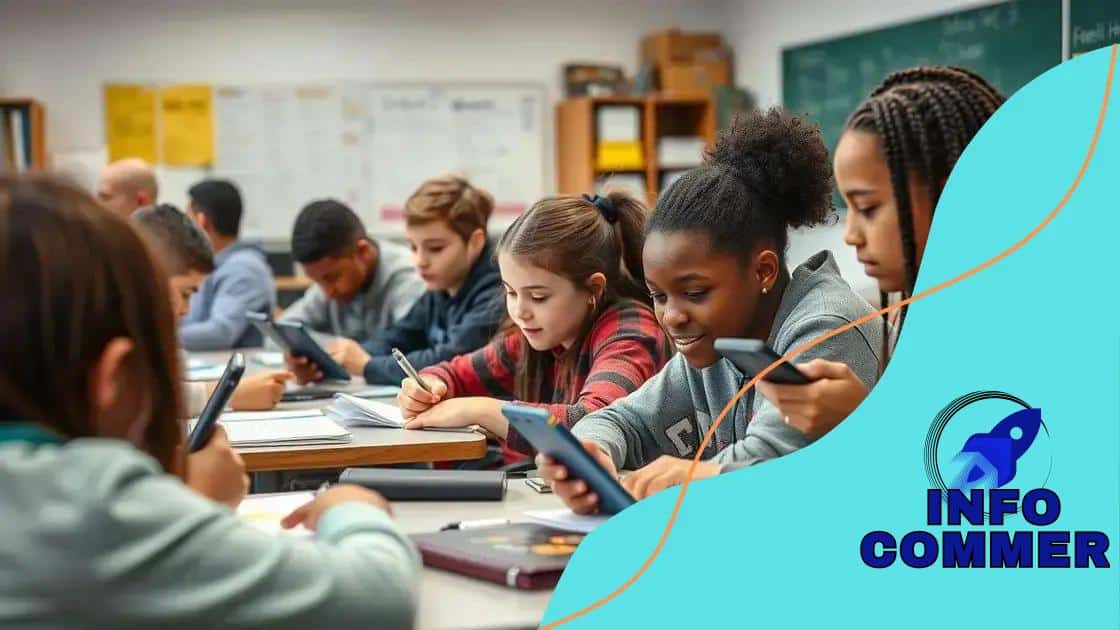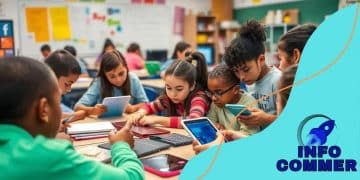Hybrid learning models for post-pandemic education

Hybrid learning models combine in-person and online education, providing students with flexibility, personalized learning experiences, and access to diverse resources, while presenting challenges that educators must navigate for effective implementation.
Hybrid learning models for post-pandemic education are reshaping how students engage with their studies. Have you considered how this approach might transform the classroom experience for you or your child?
Understanding hybrid learning models
Understanding hybrid learning models is essential for grasping how education is evolving. These models combine in-person and online learning, offering flexibility to both teachers and students. The goal is to create an engaging learning environment that caters to different needs.
What Are Hybrid Learning Models?
Hybrid learning models integrate traditional face-to-face teaching with digital resources. This approach allows for a more personalized learning experience. For example, students can attend some classes physically and complete other lessons online, which can help them balance their time more effectively.
Benefits of Hybrid Learning
- Flexibility in scheduling
- Access to a wider range of resources
- Increased engagement through varied teaching methods
- Improved learning outcomes through tailored experiences
With hybrid learning models, students can engage with materials at their own pace. This self-directed learning style is beneficial for those who may need extra time to understand certain topics. Moreover, teachers can leverage technology to enhance their lessons, making them more interactive and appealing.
Another key aspect is the support system that these models foster. Online platforms allow for seamless communication between students and instructors. This means that even if a student is learning from home, they can still seek help and advice readily. Schools that implement hybrid learning often see a stronger sense of community, as students stay connected through digital channels.
Challenges of Hybrid Learning Models
Despite the advantages, there are challenges to consider. It requires proper training for educators to effectively use technology. Additionally, not all students may have access to the necessary tools or a stable internet connection. Addressing these issues is crucial to ensure that hybrid learning models benefit everyone equally.
As we adapt to new educational paradigms, hybrid learning is becoming a prevalent solution. It’s a tool that enables a variety of pedagogical strategies, making education more accessible to diverse learners. It paves the way for future innovations, setting a foundation for a more effective learning landscape.
Benefits of hybrid learning in education
The benefits of hybrid learning in education are becoming more evident as schools adapt to evolving needs. This model blends traditional teaching with modern technology, offering unique advantages.
Increased Flexibility
One of the primary benefits is flexibility. Students can learn at their own pace, choosing when and where to study. This adaptability makes it easier for them to balance academic responsibilities with personal commitments.
Access to Diverse Resources
Hybrid learning also provides access to a broader range of educational materials. Students can explore online resources, videos, and interactive content. This variety caters to different learning styles, making lessons more engaging.
Personalized Learning Experience
- Tailored lessons to fit individual needs
- Opportunities for self-directed learning
- Increased motivation through choice
- More time for one-on-one support from teachers
With hybrid models, educators can provide a more personalized learning experience. Teachers can use data from online platforms to identify which areas students struggle with and offer targeted support. This approach can result in better academic outcomes as students receive the help they need.
Another advantage is the development of important skills. As students engage with technology, they gain digital literacy. These skills are essential in today’s job market, preparing them for future careers. Additionally, hybrid learning promotes self-discipline and time management, vital skills for success.
Enhanced Collaboration
Hybrid learning encourages collaboration between students, even when they are not in the same physical space. Online discussion forums and group projects allow them to share ideas and learn from one another. This sense of community can enhance motivation and make education more enjoyable.
Overall, the benefits of hybrid learning in education go beyond convenience. This approach creates an engaging and supportive learning environment, fostering academic success and equipping students with crucial life skills.
Challenges educators face with hybrid models

Challenges educators face with hybrid models can impact the effectiveness of teaching. These models, while beneficial, come with obstacles that need to be addressed for successful implementation.
Technology Access and Training
One major challenge is ensuring all students have access to the necessary technology. Not every student has a laptop or reliable internet at home. This digital divide can create inequities in learning. Additionally, teachers must be well-trained to use these technologies effectively.
If educators lack proper training, they may struggle to engage students online. This can lead to frustration both in teachers and students. Providing adequate training and resources is crucial to overcome this barrier.
Maintaining Student Engagement
Another hurdle involves keeping students engaged in a hybrid setting. When students learn online, they might feel isolated or distracted. Teachers need to find ways to make online lessons interactive and fun. Creative activities, such as group projects and discussions, help to foster a sense of community.
- Using interactive tools for lessons
- Incorporating real-world applications
- Encouraging peer collaboration
- Setting clear expectations for participation
In hybrid learning, communication becomes essential. Educators need to maintain open lines of communication to check in with students regularly. This ensures that students feel supported, whether they are learning in class or online.
Balancing Curricula
Balancing curricula between in-person and online components can also be demanding. Teachers have to decide which lessons work best in each format. For example, subjects requiring hands-on activities may need more in-person time, while others may thrive online. Finding this balance is key to optimizing the learning experience.
As educators navigate these challenges, it’s important to remain adaptable. Each classroom setting is unique, and what works for one group may not work for another. By being flexible and open to feedback, teachers can refine their approaches to hybrid learning.
Best practices for implementing hybrid learning
To successfully implement hybrid learning models, educators should follow a set of best practices. These guidelines help ensure that both in-person and online learning are effective and engaging for all students.
Establish Clear Objectives
First, it’s crucial to establish clear learning objectives. What do you want your students to achieve? By having defined goals, teachers can structure their lessons to meet these outcomes. This can guide both classroom activities and online assignments.
Utilize Technology Effectively
Using technology is at the heart of hybrid learning. Tools like video conferencing, educational apps, and learning management systems can enhance the teaching experience. For instance, applications like Google Classroom make it easy to share resources and assignments. Teachers should choose tools that fit their teaching style and their students’ needs. A well-chosen platform can streamline communication and foster collaboration.
- Encourage interactive activities online
- Use multimedia resources to cater to different learning styles
- Implement regular quizzes for understanding
- Promote discussions through online forums
Engaging students online is just as important as in-person learning. Incorporating videos, polls, and breakout groups can make virtual classes lively and fun. Interactive elements keep students focused and interested, which is crucial for learning retention.
Foster Collaboration
Collaboration between students is another key element. Encourage group projects that can be completed both online and in class. This approach promotes teamwork and strengthens communication skills. When students work together, they learn to share ideas and problem-solve collectively.
Communicate Regularly
Regular communication is vital in a hybrid learning environment. Teachers should check in with students to assess their understanding and offer support. Sending out weekly updates and reminders helps keep everyone on track. Open channels of communication also make students feel more connected and engaged.
Lastly, providing feedback is essential. Timely responses to student work can guide their learning. Positive reinforcement motivates students to keep trying and improves their overall performance.
Future trends in hybrid education
Future trends in hybrid education are evolving rapidly as technology continues to shape learning environments. One major trend is the increased use of artificial intelligence in education. AI can provide personalized learning experiences for students, adapting lessons based on individual needs and performance.
Personalized Learning Experiences
With AI tools, teachers can track student progress in real-time. This data allows educators to tailor lessons to help students who may be struggling with certain topics. Additionally, AI can assist in providing instant feedback on assignments, which keeps students engaged and motivated.
Blended Learning Approaches
The blended learning approach is also on the rise. This model combines traditional classroom settings with online learning, creating a more flexible schedule for students. For example, students might attend school in person for core subjects and engage in online courses for electives. This flexibility allows learners to explore interests outside the classroom.
- Integrating virtual reality for immersive experiences
- Expanding access to international courses
- Promoting project-based learning that blends online and offline methods
- Utilizing gamification to enhance engagement
Students enjoy learning through games and interactive platforms. As gamification becomes more popular, educational institutions are integrating game mechanics into their curricula. This trend helps make learning more enjoyable and encourages student participation.
Collaboration and Global Classrooms
Collaboration is another essential aspect of future hybrid education. Digital tools enable students from around the world to connect and work together on projects. This exposure to diverse perspectives enriches the learning experience and enhances cultural awareness.
Additionally, we can expect increased emphasis on social-emotional learning (SEL). Educators will focus on developing skills like empathy, resilience, and collaboration. As the world becomes more interconnected, these skills will be crucial for students’ success.
FAQ – Frequently Asked Questions about Hybrid Learning Models
What are hybrid learning models?
Hybrid learning models combine in-person and online education, allowing students to benefit from both formats.
How can technology improve hybrid education?
Technology enables personalized learning experiences, enhances student engagement, and facilitates communication between teachers and students.
What challenges do teachers face with hybrid learning?
Teachers may encounter issues with technology access, maintaining student engagement, and balancing online and in-person curricula.
What are the future trends in hybrid education?
Future trends include increased use of AI for personalized learning, greater collaboration opportunities, and a focus on social-emotional learning.





